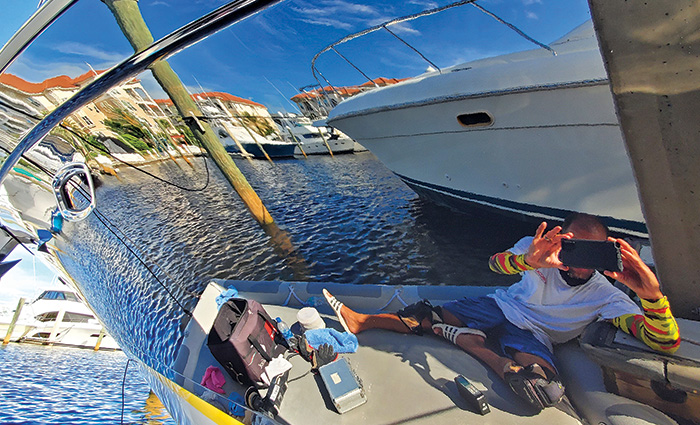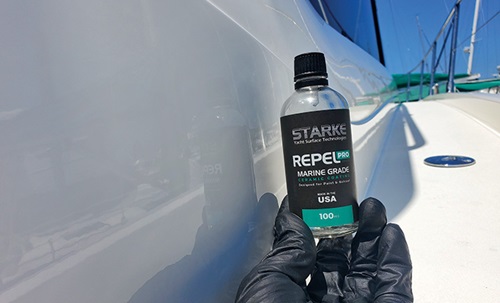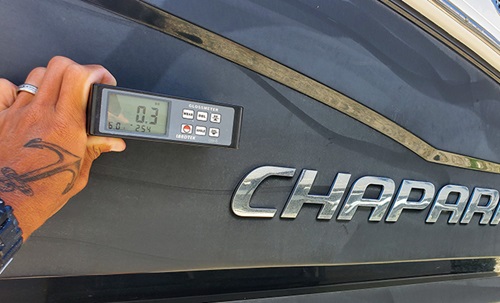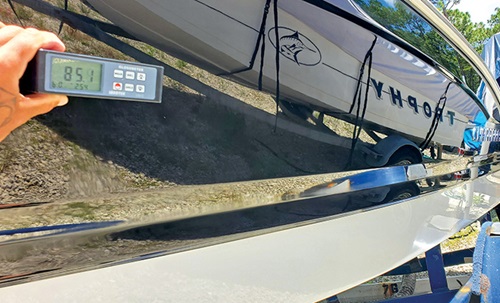Advertisement
Our editor investigates the marketing claims of consumer-grade ceramic coatings

Photo: It's About Time Yacht Restorations
Few things are as satisfying as the gleam of freshly waxed gelcoat. But few things are as depressing as the drab look of those same hullsides a few short months later. The problem? Wax simply doesn’t last. And while it’s generally considered the number-one weapon in our oxidation-prevention arsenal, it’s woefully inadequate unless you wax your boat every six to eight weeks. Yikes! That’s an awful lot of work!
Wouldn’t it be nice if there was some magic-infused product that eliminated the need? Something that kept your boat looking shiny, new, and oxidation-free for months on end?
If you’ve been paying attention to the new maintenance products popping up on the shelves of boating supply stores, you’ve probably seen what are called ceramic coatings. These have proven popular in the automotive world, and we’re now seeing more and more that are designed for fiberglass gelcoat. They’ve arrived on the scene with an impressive level of marketing hype and rather amazing claims, including that if you use this stuff, you’ll never have to wax your boat again. You might be wondering if this sounds too good to be true. We certainly did, so we decided to dig a bit deeper – and put this stuff to the test.
The dramatic ceramic
Ceramic coatings are liquid polymers with silicon dioxide particles, often advertised as “nanoparticles” (which just means they’re really, really tiny) in one of several forms. When the coating is applied, the particles fill the gelcoat’s porous surface and, as the liquid part of the coating cures, it forms a hard, glossy layer that protects the fiberglass and prevents oxidation. Many products boast high silicon content and, as a rule of thumb, more is better; but it’s not the single determining factor of how well a ceramic coating does or doesn’t work. Hardness is another characteristic to consider, which is generally tested and ranked via single point scratch testing (sometimes referred to as “pencil hardness”) or the Mohs mineral hardness scale, with better scratch resistance reflected by a higher number. The American Society for Testing and Materials (ASTM) uses scratch testing as it’s considered ideal for testing the hardness of a film as opposed to a solid object. Hardness may be a good thing, but, again, it alone is not an ideal measure of effectiveness, because a coating that ranks high may be prone to cracking or flaking due to a lack of flexibility.
Once applied, a ceramic coating should repel dirt and contaminants, bead water, and protect from UV damage for a vastly extended period as compared to wax. In short, it does what wax does but for longer, while also giving it a gloss and shine that wax simply can’t match. Note, however, that the boat must still be properly maintained with regular washing to keep it looking good, and every few months (the exact time frame differs by product and by climate) a spray-and-wipe aftercare product may be called for to give the surface a “sacrificial” layer.

Applying the DIY ceramic coating is a simple wipe-on, wipe-off affair. Photo: Lenny Rudow

The DIY ceramic coating may not have offered the same level of protection as a professional job, but the gleam in that gelcoat is incredible. Photo: James Ronayne
Pro V Me
There’s a big dichotomy between professional ceramic coating jobs and the DIY variety. Professional applications can cost between $50 and $100 per foot of boat and are intended to last up to several years, depending to a large degree on where and how the boat is stored. These jobs have a high rate of satisfaction and may come with a warranty for a certain performance over a specified time frame, commonly a matter of years.
Off-the-shelf consumer DIY products range from around $40 to $150 for enough to coat a boat up to 25 feet, and generally claim to deliver anywhere from six months to several years of protection. Obviously, this is a much lower cost – but you’ll have to do all the prep work and application yourself, with no assurance that the job will come out as you expect. And there are differences in what goes into the products.
“There’s a huge difference between professional products and consumer-grade,” says Francisco Sprott, owner of It’s Aboat Time Yacht Restorations in St. Augustine, Florida (itsaboattimeboatcleaningfl.com). Sprott is a Ceramic Pro Certified Installer who spent years detailing boats at a dealership before starting his own business and specializing in applying Ceramic Pro and Starke Yacht Care ceramic coatings.
“The companies that make professional-grade products generally don’t even sell those products directly to the consumer,” he notes. “They want to make sure it’s applied properly, and a ceramic coating has to be applied by someone who’s trained and certified to get the best results. The boat also has to be prepped properly, which may be 80% or 90% of the time involved in a job.”
Just what prep is necessary? It all depends on the current condition of the boat, but there’s a bottom line: Like a new paint job, flaws and imperfections don’t get covered up. “All oxidation, scratches or swirls, and existing wax must be removed,” says Sprott. “And if you coat a defective surface, you just seal in all the imperfections. You also have to take the environment and whether the boat is indoors or outdoors into account. For example, a high pollen count in the air can turn the coating yellow. The humidity has to be correct. Also, if it’s too cold, the coating may not bond properly. And since it dries faster at high temperatures, you may have to work differently and apply it to smaller areas in the heat.”
What happens when it’s time to reapply? “When a ceramic coating has reached its expiration, there are only two ways to remove it,” says Sprott. Wet sanding or with heavy cutting compounds. “Basically it’s restarting the process of surface correction before reapplication.”

As is true of a paint job, the bulk of the labor is in the prep work. Photo: It's About Time Yacht Restorations

Starke ceramic coatings are one of Francisco Sprott’s professional-grade products of choice. Photo: It's About Time Yacht Restorations
Test case scenario
To see how much work is involved and what sort of results we can expect from a quick and easy DIY job, we tried treating a 26 Caymas HB (in excellent condition with no restoration necessary) with one of the newer consumer products out there, Gtechniq Ceramic Fast Coat. Gtechniq (gtechniq.com), which also makes professional-grade ceramic coatings, has been in the automotive market for more than 20 years and offers several levels of products including Ceramic Fast Coat, which was introduced for the marine market in 2019. At $39.95 a bottle it promises up to six months of protection with an easy DIY application.
Spraying the product on a microfiber cloth, spreading it on the surface in a crosshatch pattern, then buffing the surface with another microfiber cloth one section at a time, the application took significantly less time than a wax job – about two-and-a-half hours to cover the 26-foot boat’s hull and smooth topside surfaces. It’s not necessary to rub it in or apply any serious pressure, nor to wait for it to dry before buffing, so application was about as easy and pain-free as one could hope for.
Upon completion, the boat looked appreciably shinier than before. In fact, the hullsides were like mirrors, and the boat looked newer and fresher than the day it was delivered – it may well have been the most beautiful gleam we’ve ever seen on any boat, no matter how many coats of wax had just been applied. A bold claim? Maybe, but just look at the picture we offer up as evidence (at right). You can clearly see the rags and Gtechniq bottles reflected in the boat’s hullside from 10 feet away. And that’s on the shaded side of the boat.
One month later, the gleam was still there, but all was not perfect in this polymer paradise. We found that in the cockpit, the regular black streak marks common to most boats took more rubbing to remove than they would with a healthy wax job or a professionally applied ceramic coat. Similarly, after we went fishing, we noted that blood stains and bait blobs required a bit of scrubbing to clean away. We could always get the offending blemishes off, but the surface just wasn’t as slick and repellent as a thick coat of wax. Two months in, we waxed over the coating on the heavy-use topsides area of the boat.
After a full six months of use and a refresher waxing midway through, the boat still looks better than, by our estimation, any other in the entire marina. True, we did resort to waxing the portion of the boat with a high ick-factor for easier cleanups. But the hullsides didn’t require it, and the look the ceramic coat gave the boat is incredible. And remember, this was a DIY job done in a couple of hours with little effort or expense.
“Spray-on products may be cost-effective for a DIY person, but they generally have a lower silicon dioxide content than a professional-grade product,” explains Sprott. “Otherwise it would clog the spray nozzle, and the conditions for application would be much more restrictive.”
The bottom line? As is true of so many things in life, when it comes to ceramic coat jobs, you get what you pay for. Take the easy, inexpensive route, and you may well be pleased with the results, but you can’t expect to get the same level of long-term protection as a professional job costing thousands of dollars. And that’s the route you’ll want to go – if you truly want to give your wax the ax.

The professional before/after difference in this Chaparral’s shine factor isn’t just obvious to the eye. Photo: It's About Time Yacht Restorations

A glossmeter shows a spectacular jump from 0.3 to 85.1.n field. Photo: It's About Time Yacht Restorations
